Radiography VR & Desktop Manual
Launch the sim
From the web portal: VR(tethered) and 2D(Desktop)
Depending on your institution’s licenses, you may have access to additional simulations. These will appear as separate icons and titles on the login screen. Choose the radiography icon by clicking on it.

On the next screen, choose a body area to practise on: Skull, Upper Limb, Torso, or Lower Limb.

Then select a specific body part within that region. For example, select Torso to see options such as Chest, Abdomen, Thoracic, or Lumbar Spine.

VR Stand-alone
If you are using VR stand-alone, log into the HMD with your Virtual Medical Coaching username and password, and then click on the X-Ray Pro VR icon.

Login options for the VR stand-alone application are: “Email and password” or “Using another device”. For more details, refer to the "Exit menu and login options" section of this manual.
Once logged in, you will see the Menu that allows you to select Body areas. These will start off broad, like Thorax and Lower Limb, and become more specific as you click through them all the way to your projection of choice. E.g. Chest Posterior Anterior.
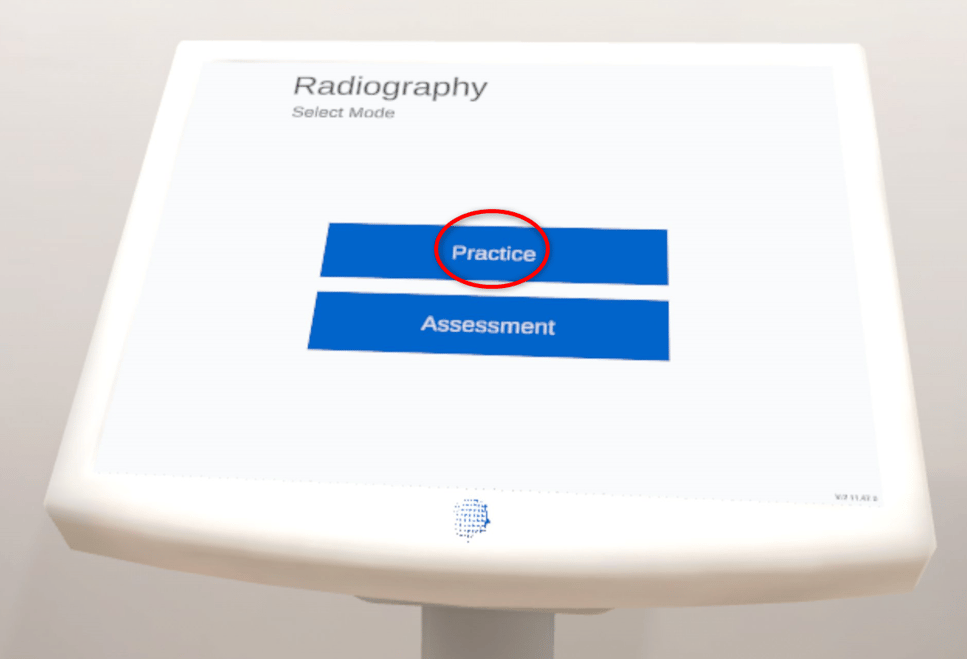
Simulation interface
VR
In VR mode, the simulation will launch directly in your head-mounted display (HMD).
You’ll be placed inside the Radiography Suite, where you can interact with the environment using your VR controllers.
2D(Desktop)
In 2D mode, the simulation will launch inside the Radiography Suite. Depending on your computer, it may open immediately or appear as an icon in your taskbar, which you need to click on this icon: ![]()
Controls
Control mappings may vary depending on your VR headset model.
Posters displayed on the walls within the VR environment show the button functions specific to your device. Please refer to these when getting started. If you need further assistance, contact us at: support@virtualmedicalcoaching.com
VR
Below is an example for the HTC Vive and HTC Vive Pro

HTC VR Controller Functions
- The top button is used for teleporting.
- The side buttons are used for gripping.
- The trigger is used for pointing and pressing your VR index finger.
These controls may vary depending on your VR headset model. Please spend a few minutes getting familiar with your controllers before starting the simulation for the first time.
Below is an example for the Meta Quest 2, 3, 3s, and Pro controllers. Note: The 3, 3s, and Pro controllers do not have the circle, but the buttons are in the same positions.

2D(Desktop)
Windows

Mac

These are navigation controls to move within the simulation and to zoom in and out
VR Interactions
VR Navigation - Teleport Function
Teleporting allows you to move around the virtual environment without physically walking, making it ideal for use in limited spaces, or you can do a mixture of both.
To teleport:
- Use the button on your controller to activate teleport mode
- Look at the area on the floor where you want to go
- Point your controller in that direction
- Press and hold the teleport button
- A green circle means the location is valid
- Release the button to move instantly to that spot

If the circle appears red, teleporting to that location isn't possible. This usually means you’re aiming at a wall, equipment tray, or other restricted area. Try pointing at a clear space on the floor instead.

VR Interaction – Grabbing and Moving Objects
The grabbing/gripping function lets you interact with equipment and position the patient within the virtual environment, just as you would in a real clinical setting.
To grab or move an object:
- Reach out toward the object
- If it highlights green, it can be gripped
- Use the button on your controller to pick it up
- While holding the object, move and position it as needed
This function is used for:
- Moving the X-ray tube
- Positioning the patient
- Removing jewelry
- Picking up cassettes or markers
- Removing or replacing the digital grid
- Collimating by turning the dials on the front of the X-ray tube
- Activating handwashing at the sink station
These actions mirror real-world tasks and help reinforce correct clinical technique.

VR Interaction – Pointing and Pressing
The pointing function is used to interact with buttons and explore anatomical structures in the virtual environment.
VR Interaction - Highlighting Skeletal Anatomy (VR only)
To view the underlying skeleton, point at the skin and press the skin using your controller. This will highlight the corresponding internal anatomy, helping you connect external landmarks with internal features.
Important: The anatomy will not appear automatically. You must actively point and press to reveal it.

Control room
In VR, walk/teleport to the Control room, where you will be able to check the patient details and select your exposure factors, etc.
In 2D(Desktop), the Skull Icon will place you in the control room where you can perform the same as you would in VR.
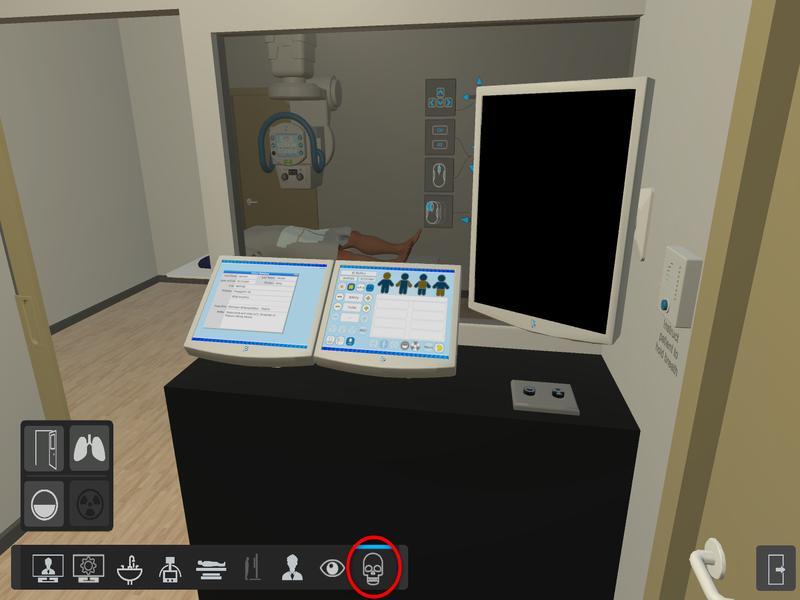
Patient information
Verify the patient identification and clinical notes to ensure they make sense for the projection.
To navigate in 2D(Desktop), press this icon.
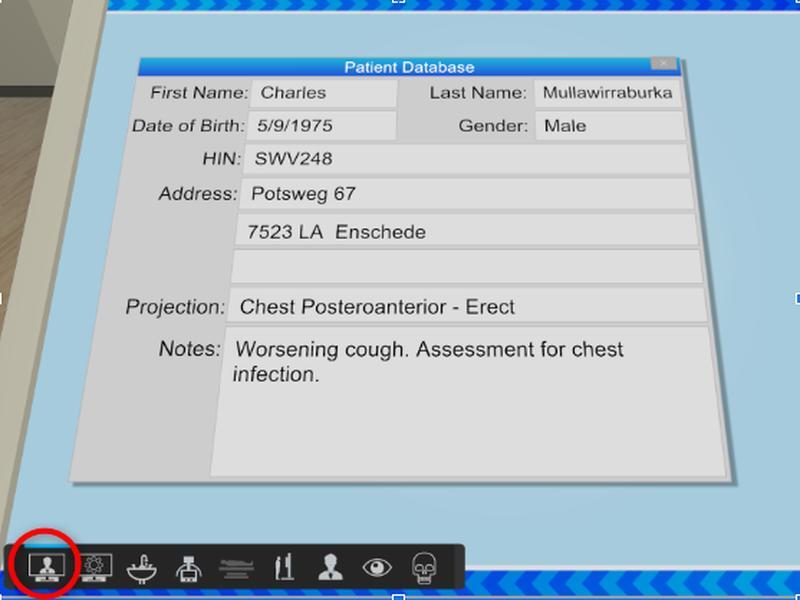
At the top right of the left-hand monitor, you can see the version number of the software you are using. This number should always match the number in the Downloads section in the VMC User Portal. If it does not, it’s time for an update. You can do this yourself on your own computer, or please let one of your instructors or the ICT team know.

Control panel settings
Whether you are in 2D or VR, the right-hand blue monitor is where you select your exposure and other technique factors.
To access that panel in 2D(Desktop), press this icon
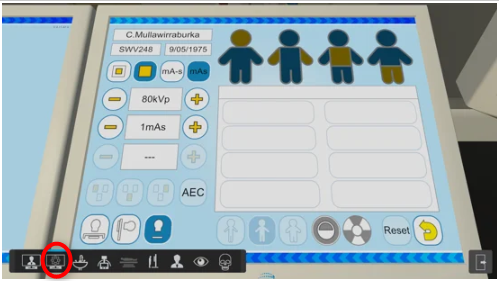
You can select a preset or manually adjust your kVp, mAs, focal spot size, AEC on or off, AEC chambers and density, and detector. Or do a mixture of both.

Note: Select the detector first, or the Source to Image Distance (SID) and Detents won’t activate.
- In VR, failure to select the detector means you won't feel the tube lock into the detents, nor will you see your Source to Image Distance (SID)
- In 2D, the green alignment lights will not activate until the detector is selected, nor will you see your Source to Image Distance (SID)
(There’s more about the green lights later in the guide.)
For a very short video on this, please watch this: https://youtu.be/vrCMeWtrInc

From left to right are Table Bucky, Erect Detector, and Free Cassette.
Handwashing
2D(Desktop)
Click the faucet/sink icon to play the handwashing animation.
VR
Grip the faucet/sink tap, soap, and then towel to trigger animations.
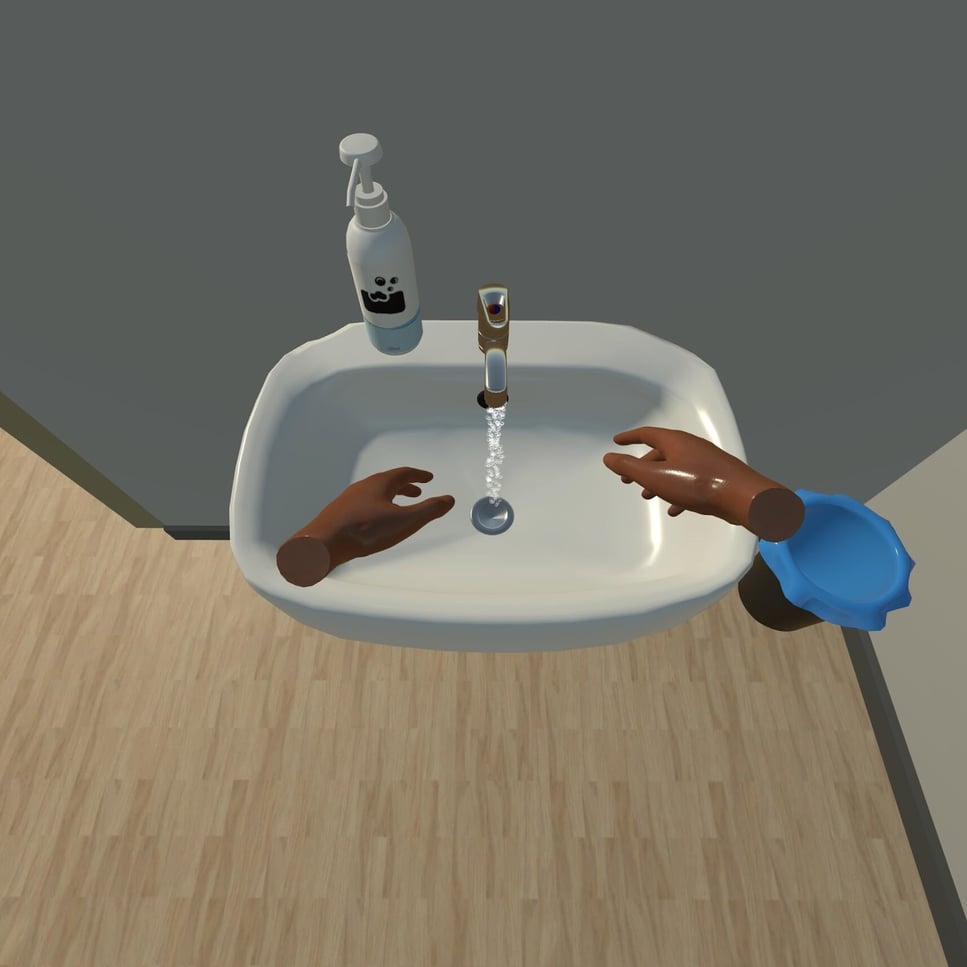
Interacting with Equipment and Patient
VR
Point and grip to interact with the tube, cassettes, and markers.
2D(Desktop)
Click UI icons to manipulate equipment and the patient.
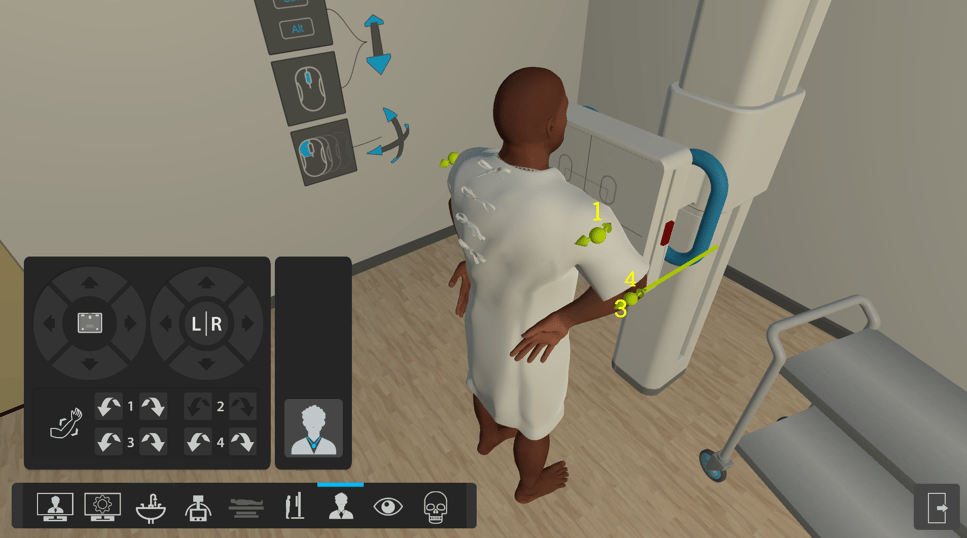
Tube Directional Controls in VR
In VR, you will notice all the X-ray tube directional buttons are locked (blue) except for the vertical button when you first log in. This is green (unlocked); therefore, you can move the tube up and down, but in no other direction.
The Light is activated by pressing the bulb button in VR. You can switch the light and laser on separately or together to check your alignment. The collimators are rotated by the two dials. If you wish to turn the light box, you can do that by manually rotating it.

Once you tap the other directional buttons so they go green, you will be able to move the tube in those directions, including turning all of the directional buttons green so you have a “free tube”. Note: only one rotation direction (left-hand side) can be used at a time.

Standing Bucky in VR
To alter the height in VR, grip the blue handle and move it up or down physically.

To remove the digital grid in VR, press the red button on the side of the erect detector.

The grid will pop out 1/3 of the way and can be removed by gripping it and placing it on the silver trolley. To reinsert the grid, push it into the empty slot, and it will snap into place.

Table Bucky in VR
In VR, pull the table Bucky out from under the table by physically gripping it and pulling it.

You will find a cassette and side markers on the silver trolley. You can pick these up and insert the cassette into the Bucky either landscape or portrait. You can place your side markers on the cassette.

Adjusting the X-ray Table in VR
To raise or lower the X-ray table, point at the square up or down buttons on the vertical post at the end of the table and press to adjust the height.

Using the Floating Top Table in VR
The floating top function is activated using the circular buttons on the same post as the height controls.
-
- Each button corresponds to a specific direction of movement
- You can press buttons individually or simultaneously
- After pressing a button, grip the table to reposition it

- Each button corresponds to a specific direction of movement
The table will highlight green to indicate that movement is enabled.

Free cassette in VR
If you are using the free cassette in VR for a projection. You will find this on the X-Ray table already. Often, it is near or already under the body part you need it to be; however, it will not be in the right position. To move this to the right position, you need to put one hand flat on it, and when it goes green, press the grip button on your controller on that hand. You can then move it to the desired position.

Positioning the Patient in VR
When your hand approaches the area of the patient you wish to move, green arrows will appear.
These arrows indicate:
- The angle and direction in which the patient can be moved
- Where to place your hands for effective positioning
The green arrow also shows which body part will rotate when movement is applied.
Each radiographic projection includes a set of available patient movements, depending on the requirements of that specific view.
This view, for example, shows the patient can be rotated by their shoulder. Sometimes, for large movements, where the patient would need to take a step, you will be offered a slider (also shown below), and you can push the slider to move the patient.

2D(Desktop)
Click the patient icon; numbered arrows correspond to movements.

Tube Directional Controls in 2D(Desktop)
Use the X-Ray tube icon for collimation, the bulb for light, and the dials to collimate.

The eye icon allows you to look out of the tube, and is often the best view to adjust the collimation and see the true position of your patient. In this view, you can also press the bulb button to turn the light on and rotate the light box and collimate.

Erect detector in 2D(Desktop)
The erect detector icon is selected, and the X-ray table icon is disabled.
Both the X-ray table and the Erect detector can be raised up/down, and the cassette inserted into the Table Bucky. The Erect Detector’s digital grid can be removed and reinserted.

Table Bucky in 2D(Desktop)
Whether you have a Table Bucky or an Erect Detector in the room, predefined by the selected projection.
The Table Bucky icon is selected, and the Erect Detector icon is disabled.

Adjusting the X-ray Table in 2D and using the Floating Top Table in 2D(Desktop)
As shown in the picture above, selecting the X-ray table on the icon tray opens a ring with arrows and two images representing the cassette. The arrows control the table movements, and the cassette arrows indicate whether you have put a cassette into the Bucky or not. The blue arrow here shows you that the cassette is not inserted. Clicking the grey arrow will put a cassette into the Bucky, and that one will turn blue, and the other one will go grey.
Centering the table Bucky in 2D for projections such as AP Abdomen can be completed using the green circle lights as your detents. Please see this short video to explain how it is done:
Free cassette in 2D(Desktop)
If you are using the free cassette in 2D(Desktop) for a projection. You will find this on the X-Ray table already. Often, it is near or already under the body part you need it to be; however, it will not be in the right position. To move this to the correct position, you will need to use the arrow buttons of the Cassette icon that can be found in the Patent view.

Positioning the patient in 2D(Desktop)
You can access the movement view by clicking on this button on the icon tray. The numbered arrows correspond to body movements on the patient. You can also apply a side marker and adjust its position here.

Jewellery and weight
2D(Desktop)
In 2D(Desktop), you can access the patient view by clicking on this button on the icon tray. And remove any jewelry if it is on the patient. The patient won’t always be wearing jewelry.

If the projection requires a weight to be held, this is where you will access that weight, too.

VR
To remove jewelry in VR, you need to physically remove it. Touch the jewelry and press the grip button on your controller. It will disappear.

Closing the door & suspending respiration
For these actions, you need to be in the Control room
2D(Desktop)
By default, the door is open and respiration is not suspended, which is reflected in icons.
Click the door/lungs icons to close & start the countdown.

You will need to shut the door by clicking the door icon; the door icon will change to the closed door

You can ask the patient to suspend their respiration by clicking the lungs icon, and the icon will change to a countdown. When the countdown reaches 0, the patient will breathe normally again.

VR
In VR, you need to close the door manually, and you can ask the patient to suspend respiration by pressing the button on the wall beside the black monitor.

Taking images
To take image(s), you need to be in the Control room.
2D (Desktop)
Press Prepare, then Expose under the skull icon.
VR
Press the Prepare then Expose buttons under the monitor.

Reviewing and Adjusting the Radiograph
Once you have obtained your radiograph(s), you can adjust the following image parameters using the menu button on the screen:
- Collimation region
- Contrast
- Brightness
- Rotation
- Zoom
Your adjusted image via the post-processing menu will not be saved; this is for viewing only.
The Deviation Index (DI) is also displayed on screen for reference.

Exit menu
When you are satisfied with your image(s) and you wish to do additional projections or quit the application, you can use the Exit menu.
2D(Desktop)
Click the Exit Door icon on the bottom right-hand side of the screen.

VR
You will see an Exit menu on the door to the right of the Radiograph display monitor in VR.

Exit menu and login options
When you exit the simulation in either VR or 2D from the portal for the first time in that session, you’ll see the following options displayed.
- Selecting a new projection will take you to a lobby where you can log back in.
- Quit Application closes the simulation application.

2D(Desktop)
In 2D, you can either log back in with your email and password or with your browser on your computer.

If you choose to log in with your email and password that you use for the VMC Web Portal, you will be taken to a screen where you should do that.

If you choose to log in with your browser, you will see the following screen (if not logged in already)

VR
If you are using tethered VR, you will need to log back in with your browser.

If you are using stand-alone VR, you will be given the option to log in with your email and password, but you can also use the ”Using another device” login option.

Once you press Using Another Device, you will get an 8-digit code and can log in that way by entering the code into the Device Login area in the VMC Web Portal.

From the second and any further times in that session, when you exit and select a new projection, you will not need to log in with your password or a code again in the lobby.
Once logged in this way, choose either Practice or Assessment simulation. Remember, the Assessment Option will have a Radiography room for you with some features disabled to push your understanding of the exposure factors.
Once your images have been created and you've exited the simulation, you should navigate to your User Portal to complete the Analysis of your images and critique.
Reports
In Reports, you will see all of the images you have taken and be able to analyse the data with each image.
Teaching staff will be able to see what work their students have done and can easily see which images have been analysed.
- Green ticks mean the series has been analysed.
- Half green ticks mean some analysis has been started but is not complete.
- A grey/gray dash means the analysis has not started.
Click on View Report to see the image and data relating to that session. All of the images you have produced in the session will be in one report. You can scroll through them.

Students cannot see each other's work, but their tutors and lecturers can see all of the students' work and analysis.



